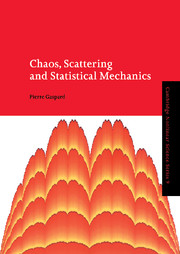Book contents
- Frontmatter
- Contents
- Preface
- Introduction
- Chapter 1 Dynamical systems and their linear stability
- Chapter 2 Topological chaos
- Chapter 3 Liouvillian dynamics
- Chapter 4 Probabilistic chaos
- Chapter 5 Chaotic scattering
- Chapter 6 Scattering theory of transport
- Chapter 7 Hydrodynamic modes of diffusion
- Chapter 8 Systems maintained out of equilibrium
- Chapter 9 Noises as microscopic chaos
- Chapter 10 Conclusions and perspectives
- References
- Index
Chapter 6 - Scattering theory of transport
Published online by Cambridge University Press: 30 January 2010
- Frontmatter
- Contents
- Preface
- Introduction
- Chapter 1 Dynamical systems and their linear stability
- Chapter 2 Topological chaos
- Chapter 3 Liouvillian dynamics
- Chapter 4 Probabilistic chaos
- Chapter 5 Chaotic scattering
- Chapter 6 Scattering theory of transport
- Chapter 7 Hydrodynamic modes of diffusion
- Chapter 8 Systems maintained out of equilibrium
- Chapter 9 Noises as microscopic chaos
- Chapter 10 Conclusions and perspectives
- References
- Index
Summary
Scattering and transport
When scattering occurs in systems of large spatial extension like solids, a relationship appears between scattering and transport. This is particularly evident in the process of transport of thermal neutrons in nuclear reactors. On the one hand, neutrons may form beams for the study of matter and, on the other hand, as soon as the target presents spatially distributed scattering centres, the scattering process becomes a diffusion process, i.e., a process of transport as studied in kinetic theory. Clearly, both processes are similar and the difference only appears in the number and distribution of scatterers. Therefore, a fundamental connection exists between scattering theory and nonequilibrium statistical mechanics. The scattering approach to diffusion is also natural since diffusion is studied in finite pieces of material in the laboratory. Diffusion is a property of bulk matter which is extrapolated from experiments on finite samples to a hypothetical infinite sample.
Classically, the scattering on a spatially distributed target may be expected to be chaotic because the collisions on spherical scatterers have a defocusing character. Chaoticity will play an important role in such a connection. In the following, we shall elaborate in this direction with the tools developed in the previous chapters to obtain the so-called escape-rate formulas for the transport coefficients, which precisely express such a relationship (Gaspard and Nicolis 1990, Gaspard and Baras 1995).
We should mention here that Lax and Phillips (1967) proposed in the sixties a scattering theory of transport phenomena based on the properties of classical dynamics.
- Type
- Chapter
- Information
- Chaos, Scattering and Statistical Mechanics , pp. 224 - 274Publisher: Cambridge University PressPrint publication year: 1998

